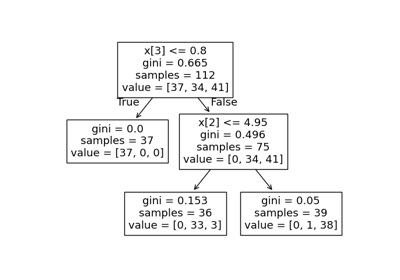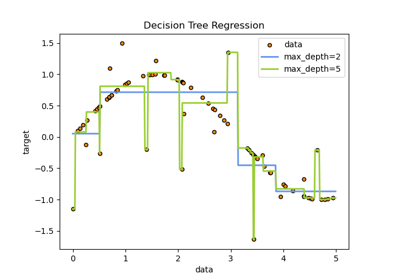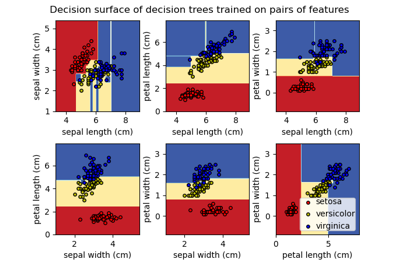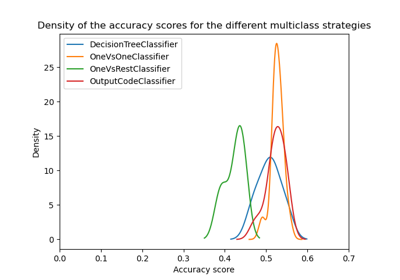注意
转到末尾 下载完整的示例代码或通过 JupyterLite 或 Binder 在浏览器中运行此示例。
使用成本复杂度剪枝对决策树进行后剪枝#
DecisionTreeClassifier 提供了诸如 min_samples_leaf 和 max_depth 等参数来防止树过度拟合。成本复杂度剪枝提供了另一种控制树大小的选项。在 DecisionTreeClassifier 中,这种剪枝技术由成本复杂度参数 ccp_alpha 参数化。更大的 ccp_alpha 值会增加剪枝的节点数。在这里,我们只展示 ccp_alpha 对树正则化的影响,以及如何根据验证分数选择 ccp_alpha。
有关剪枝的详细信息,请参阅 最小成本复杂度剪枝。
# Authors: The scikit-learn developers
# SPDX-License-Identifier: BSD-3-Clause
import matplotlib.pyplot as plt
from sklearn.datasets import load_breast_cancer
from sklearn.model_selection import train_test_split
from sklearn.tree import DecisionTreeClassifier
叶子总杂质与剪枝树的有效 alpha 值#
最小成本复杂度剪枝递归地找到具有“最弱链接”的节点。最弱链接的特征是有效 alpha 值,其中具有最小有效 alpha 值的节点首先被剪枝。为了了解哪些 ccp_alpha 值可能合适,scikit-learn 提供了 DecisionTreeClassifier.cost_complexity_pruning_path,它返回剪枝过程中每一步的有效 alpha 值和相应的叶子总杂质。随着 alpha 值的增加,更多的树被剪枝,这增加了其叶子的总杂质。
X, y = load_breast_cancer(return_X_y=True)
X_train, X_test, y_train, y_test = train_test_split(X, y, random_state=0)
clf = DecisionTreeClassifier(random_state=0)
path = clf.cost_complexity_pruning_path(X_train, y_train)
ccp_alphas, impurities = path.ccp_alphas, path.impurities
在下面的图中,移除了最大有效 alpha 值,因为它是一棵只有一个节点的普通树。
fig, ax = plt.subplots()
ax.plot(ccp_alphas[:-1], impurities[:-1], marker="o", drawstyle="steps-post")
ax.set_xlabel("effective alpha")
ax.set_ylabel("total impurity of leaves")
ax.set_title("Total Impurity vs effective alpha for training set")

Text(0.5, 1.0, 'Total Impurity vs effective alpha for training set')
接下来,我们使用有效 alpha 值训练决策树。ccp_alphas 中的最后一个值是剪枝整个树的 alpha 值,留下树 clfs[-1] 只有一个节点。
clfs = []
for ccp_alpha in ccp_alphas:
clf = DecisionTreeClassifier(random_state=0, ccp_alpha=ccp_alpha)
clf.fit(X_train, y_train)
clfs.append(clf)
print(
"Number of nodes in the last tree is: {} with ccp_alpha: {}".format(
clfs[-1].tree_.node_count, ccp_alphas[-1]
)
)
Number of nodes in the last tree is: 1 with ccp_alpha: 0.3272984419327777
对于本例的其余部分,我们移除了 clfs 和 ccp_alphas 中的最后一个元素,因为它是一棵只有一个节点的普通树。在这里,我们展示了节点数和树深度随着 alpha 值的增加而减少。
clfs = clfs[:-1]
ccp_alphas = ccp_alphas[:-1]
node_counts = [clf.tree_.node_count for clf in clfs]
depth = [clf.tree_.max_depth for clf in clfs]
fig, ax = plt.subplots(2, 1)
ax[0].plot(ccp_alphas, node_counts, marker="o", drawstyle="steps-post")
ax[0].set_xlabel("alpha")
ax[0].set_ylabel("number of nodes")
ax[0].set_title("Number of nodes vs alpha")
ax[1].plot(ccp_alphas, depth, marker="o", drawstyle="steps-post")
ax[1].set_xlabel("alpha")
ax[1].set_ylabel("depth of tree")
ax[1].set_title("Depth vs alpha")
fig.tight_layout()
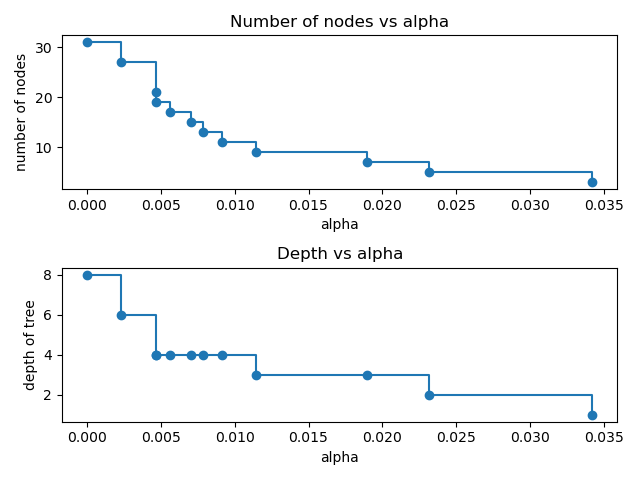
训练集和测试集的准确性与 alpha 值#
当 ccp_alpha 设置为零并保持 DecisionTreeClassifier 的其他默认参数时,树会过度拟合,导致 100% 的训练准确性和 88% 的测试准确性。随着 alpha 值的增加,更多的树被剪枝,从而创建了一个泛化能力更好的决策树。在这个例子中,设置 ccp_alpha=0.015 可以使测试准确性最大化。
train_scores = [clf.score(X_train, y_train) for clf in clfs]
test_scores = [clf.score(X_test, y_test) for clf in clfs]
fig, ax = plt.subplots()
ax.set_xlabel("alpha")
ax.set_ylabel("accuracy")
ax.set_title("Accuracy vs alpha for training and testing sets")
ax.plot(ccp_alphas, train_scores, marker="o", label="train", drawstyle="steps-post")
ax.plot(ccp_alphas, test_scores, marker="o", label="test", drawstyle="steps-post")
ax.legend()
plt.show()
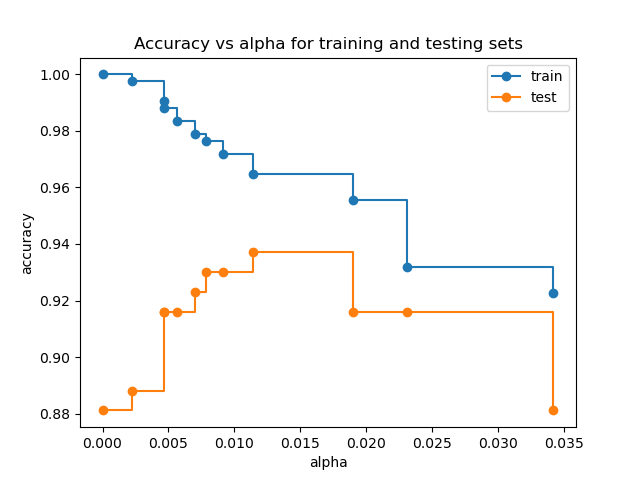
脚本总运行时间: (0 分钟 0.380 秒)
相关示例
